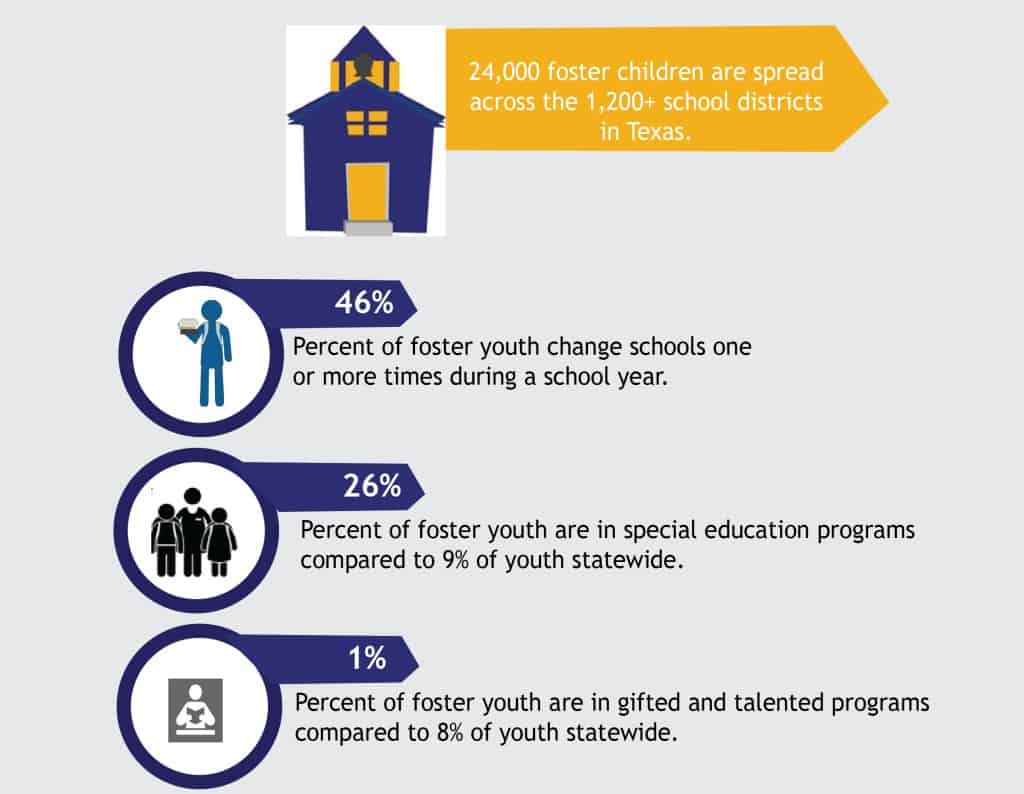This May, more than eight thousand students at The University of Texas at Austin walked across the stage at graduation and went on to embark on their chosen career paths. Less than .01% of these proud Longhorns were former foster youth, despite the fact that youth who age out of the foster care system in Texas receive free tuition. Researchers at the School of Social Work’s Child and Family Research Institute (CFRI) are working to make this better.
“We know foster youth have poor educational outcomes, in Texas and across the country. They are less likely to finish high school, less likely to go to college, and less likely to have stable employment,” said Dr. Monica Faulkner, CFRI’s Associate Director.
For the past two years, a team led by Drs. Faulkner and Beth Gerlach have been working with multiple state agencies to help understand why former foster youth struggle to even graduate from high school.
“To start with, most people are shocked to hear that our schools and foster care system historically did not talk to each other about our state’s most vulnerable children,” Faulkner explained. “Even today, many school districts do not even know which of their students are in foster care. Schools and child welfare systems are governed by laws that require them to maintain confidentiality, which is good, but at the same time make the sharing of data very difficult when needed.”
In 2012, Faulkner and Gerlach worked alongside the Texas Education Agency (TEA), The Texas Department of Family and Protective Services (DFPS) and the Supreme Court of Texas Permanent Judicial Commission for Children, Youth, and Families (Children’s Commission) to develop strategies for the foster care and education systems to decide what data to share and how.
The CFRI team also issued recommendations, which are now being used to finally produce reliable graduation and attendance rates for foster youth in Texas schools.
“The most important lesson we learned from this project was how to work together to address the educational challenges of students in foster care. No one system can do it alone,” said Tina Amberboy, Executive Director of the Children’s Commission. “Now our state is really looking at the data exchanged and how we can more effectively use it to change practices and policies.”
As a result of this collaboration, in 2013, Faulkner and CFRI research coordinator Laura Marra were invited to sit on the Data Workgroup of the Texas BluePrint Implementation Taskforce as part of the Children’s Commission’s foster care and education initiatives. The Data Workgroup supports efforts of TEA and DFPS to produce annual reports detailing the number of foster youth attending school in each of the 1,200 Texas school districts.
“Texas is improving by leaps and bounds compared to other states. Imagine being removed from your home and having to start a different school all in the same week. These are traumatic events for children. We have to restructure our systems and policies to minimize the trauma so children can succeed and excel in school,” Gerlach said.
CFRI researchers find it very satisfying to see policy changes stemming from their work, but they also feel that their efforts have just begun. Building on previous work on public school issues, they are now focusing on higher education, and on The University of Texas at Austin specifically.
“In fall 2013, only 14 former foster youth activated their tuition waivers at UT,” Faulkner stated. “The university currently does not track foster youth on campus, and there are no specific programs to recruit and retain foster youth.”
Faulkner and Gerlach are starting programming efforts to connect former foster youth to higher education opportunities in the Forty Acres. As a first step, they are hiring two former foster youth to their team.
“Earlier this year, DFPS approached us to host one of their Youth Specialist positions,” Faulkner said. “DFPS has traditionally used this position to hire a former foster youth to organize and advocate for youth currently in care. By placing this position here at UT, we are creating a key link between current and former foster youth and higher education.”
Posted June 2, 2014. By M. Andrea Campetella


